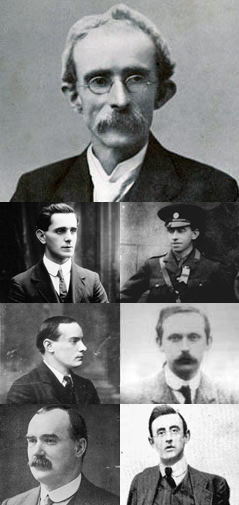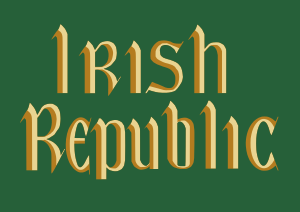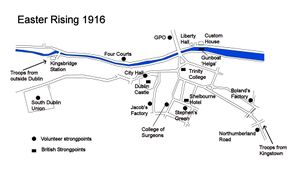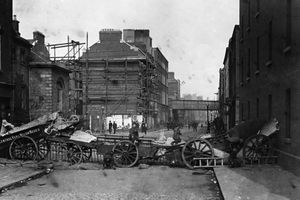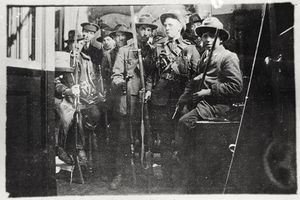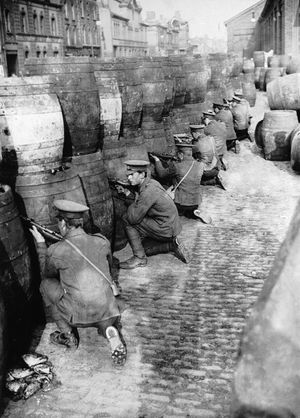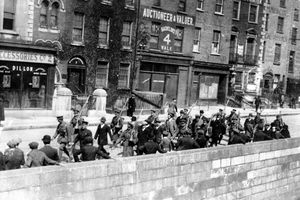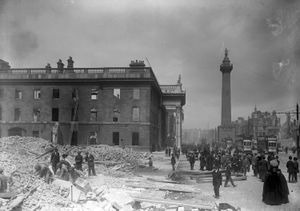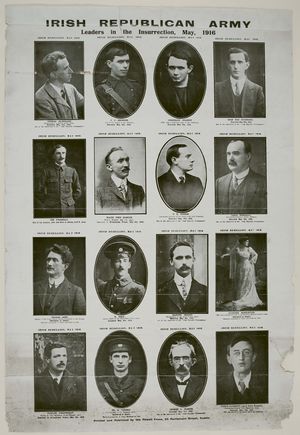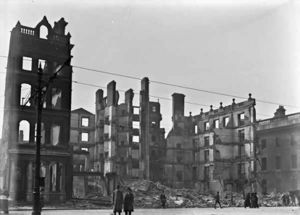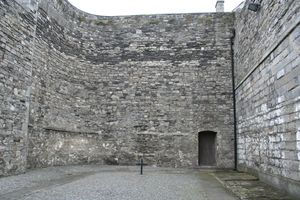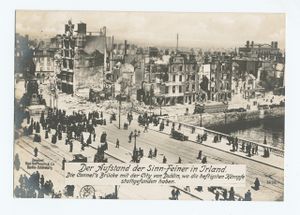انتفاضة عيد الفصح
| Easter Rising Éirí Amach na Cásca | |||||||
|---|---|---|---|---|---|---|---|
| جزء من الفترة الثورية الأيرلندية | |||||||
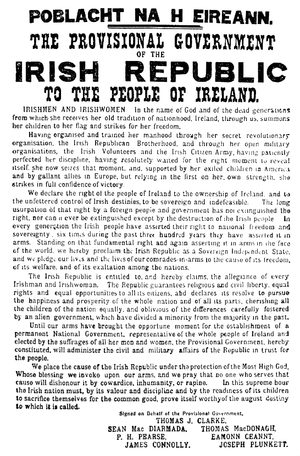 Proclamation of the Republic, Easter 1916 | |||||||
| |||||||
| المتحاربون | |||||||
|
قالب:Country data Irish Republic Irish rebel forces: Irish Volunteers Irish Citizen Army Fianna Eireann |
British Army Royal Irish Constabulary | ||||||
| القادة والزعماء | |||||||
|
Patrick Pearse James Connolly Tom Clarke Seán MacDermott Joseph Plunkett Éamonn Ceannt Thomas MacDonagh |
Lord Wimborne Augustine Birrell Matthew Nathan Lord French Lovick Friend John Maxwell William Lowe | ||||||
| القوى | |||||||
|
1,250 in Dublin, ~2,000–3,000 volunteers elsewhere but they took little part in the fighting. | 16,000 British troops and 1,000 armed RIC in Dublin by the end of the week. | ||||||
| الضحايا والخسائر | |||||||
|
66 killed 16 executed unknown wounded |
143 killed 397 wounded | ||||||
|
260 civilians killed 2,200+ civilians wounded (including unknown number of rebels) Total killed: 485 | |||||||
قالب:Campaignbox Irish independence
انتفاضة عيد الفصح (أيرلندية: Éirí Amach na Cásca،[1] إنگليزية: Easter Rising)، وتُعرف أيضاً بالانتفاضة الأيرلندية، كانت تمرداً مسلحاً في أيرلندا خلال أسبوع عيد الفصح، أپريل 1916. بدأت الانتفاضة على يد الجمهوريين الإيرلنديين بهدف إنهاء الحكم البريطاني في أيرلندا وتأسيس جمهورية أيرلندا المستقلة بينما كانت تحارب المملكة المتحدة في الحرب العالمية الأولى. كانت الأهم بين الانتفاضة في أيرلندا منذ ثورة عام 1798 وأول حركة مسلحة من الفترة الثورية الأيرلندية. أعدم ستة عشر شخصاً من قادة الانتفاضة في مايو 1916، ولكن العصيان وطبيعة الإعدامات والتطورات السياسية اللاحقة ساهمت في تضخيم الدعم الشعبي للاستقلال الأيرلندي.
نظمت على يد مجلس عسكري مؤلف من سبعة أشخاص يدعى أخوية الجمهوريين الأيرلندية، بدأت الانتفاضة في اثنين عيد الفصح، 24 أپريل 1916 واستمرت لستة أيام [2] أعضاءالمتطوعون الأيرلنديون بقيادة العلامة والناشط اللغوي باتريك بيرس، وانضم إليهجيش المواطنين الأيرلنديين الأصغر التابع لـ جايمس كونولي ومئتا امرأة من مجلس النساء. سيطروا على مبان ذات أهمية استراتيجية في دبلن وأعلنوا الجمهورية الأيرلندية. جلب الجيش البريطاني آلاف التعزيزات بالإضافة إلى المدفعية الثقيلة والقوارب الحربية. كان هناك قتال شوارع في الطرقات المؤدية إلى قلب المدينة، حيث أبطأ الثوار من تقدم البريطانيين وتسببوا بأضرار جسيمة. في مناطق أخرى من دبلن، كان القتال عبارة عن القنص ومارك بالسلاح الناري طويلة المدى. حوصرت مواقع الثوار الأساسية تدريجياً وقصفت بالمدفعية الثقيلة. ظهرت أعمال متفرقة في مناطق أخرى من أيرلندا. أصدر قائد المتطوعين إيون مكنيل أمراً بالتراجع لإنهاء الانتفاضة، مما قلل بشكل كبير عدد الثوار الذين كانوا محتشدين.
بسبب امتلاكه عدداً أكبر وأسلحة من عيار أثقل، تمكن الجيش البريطاني من قمع الانتفاضة. وافق بيرس على استسلام غير مشروط يوم السبت 29 أپريل، ورغم ذلك استمرت القتالات المتفرقة لفترة قصيرة. بقيت البلاد بعد الاستسلام خاضعة لـ الحكم العسكري. احتجز قرابة 3500 شخص كسجناء من قبل البريطانيين وأرسل 1800 منهم إلى معسكرات اعتقال أو سجون في بريطانيا. أعدم معظم قادة الانتفاضة بعد محاكمات عسكرية. أعادت الانتفاضةالقوى الجماهيريةإلى صدارة السياسة الأيرلندية، التي كانت تحت سيطرة الأممية الدستورية لقرابة خمسين عاماً. ساهمت المعارضة لرد الفعل البريطاني إزاء الانتفاضة في تغيير الرأي العام وفي الحركة نحو الاستقلال، كما اتضح في انتخابات ديسمبر 1918 والتي فاز بها حزب سين فين، والذي عقدالبرلمان الأول وأعلن الاستقلال.
من بين الـ485 شخصاً الذين قتلوا في انتفاضة عيد الفصح: 45 بالمئة كانوا من المدنيين، 30 بالمئة من الجيش البريطاني والشرطة و16 بالمئة كانوا من الثوار الأيرلنديين. أصيب أكثر من 2500 شخص. من قتل وأصيب من المدنيين كان بسبب المدفعية البريطانية والأسلحة أو اعتبروا بالخطأ من الثوار. علق البقية في تبادل إطلاق النار في المدينة المزدحمة. تسبب القصف والنار التي نتجت عنه بتدمير أجزاء في قلب دبلن.
خلفية
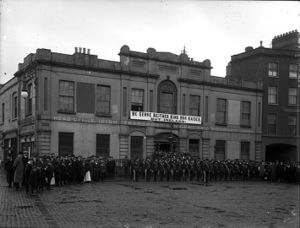
التخطيط للانتفاضة
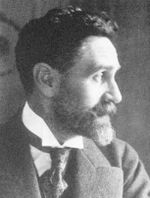
التصاعد إلى أسبوع الفصح
الانتفاضة في دبلن
إثنين عيد الفصح
الثلاثاء والأربعاء

الخميس إلى السبت
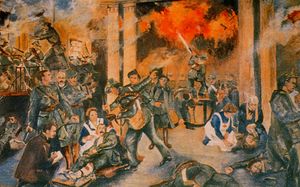
الاستسلام
الانتفاضة خارج دبلن
Irish Volunteer units mobilised on Easter Sunday in several places outside of Dublin, but because of Eoin MacNeill's countermanding order, most of them returned home without fighting. In addition, because of the interception of the German arms aboard the Aud, the provincial Volunteer units were very poorly armed.
Enniscorthy
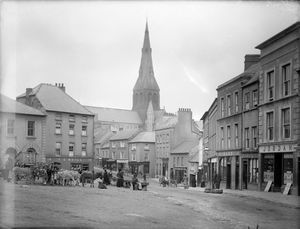
الخسائر
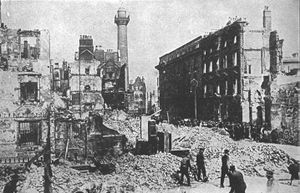
الأعقاب
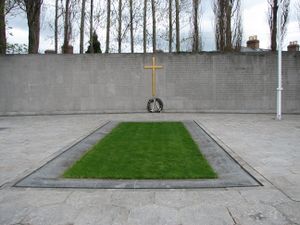
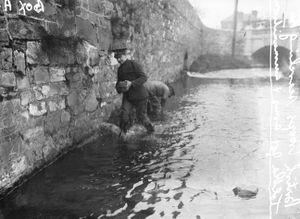
انظر أيضاً
المراجع
- ^ "Department of the Taoiseach – Easter Rising". Taoiseach.gov.ie. Retrieved 13 November 2011.
- ^ Leaders and Men of the Easter Rising: Dublin 1916 Francis X. Martin 1967 p105
- ^ "Statement by Joseph Sweeney Curious Journey: An Oral History of Ireland's Unfinished Revolution". BBC. Retrieved 18 October 2009.
ببليوگرافيا
- Augusteijn, Joost (ed.)The Memoirs of John M. Regan, a Catholic Officer in the RIC and RUC, 1909–48, Witnessed Rising, ISBN 978-1-84682-069-4.
- Bell, J. Bowyer. The Secret Army: The IRA. ISBN 1-85371-813-0.
- Caulfield, Max, The Easter Rebellion, Dublin 1916 ISBN 1-57098-042-X
- Clayton, Xander (2007). Aud. Plymouth: GAC. ISBN 9780955562204.
- Coogan, Tim Pat, 1916: The Easter Rising (2001) ISBN 0-304-35902-5
- Coogan, Tim Pat, The IRA (2nd ed. 2000), ISBN 0-00-653155-5
- De Rosa, Peter. Rebels: The Irish Rising of 1916. Fawcett Columbine, New York. 1990. ISBN 0-449-90682-5
- Eberspächer, Cord/Wiechmann, Gerhard: "Erfolg Revolution kann Krieg entscheiden". Der Einsatz von S.M.H. LIBAU im irischen Osteraufstand 1916 ("Successful revolution may decide war". The use of S.M.H. LIBAU in the Irish Easter rising 1916), in: Schiff & Zeit, Nr. 67, Frühjahr 2008, S. 2–16.
- Ellis, Peter Berresford (2008). "1916: Insurrection or Rebellion? Making Judgements". In O'Donnell, Ruán (ed.). The Impact of the 1916 Rising: Among the Nations. Dublin: Irish Academic Press. ISBN 978-0-7165-2965-1.
- Feeney, Brian, Sinn Féin: A Hundred Turbulent Years, O'Brien Press, 2002, ISBN 0-86278-695-9
- Foster, R. F. Vivid Faces: The Revolutionary Generation in Ireland, 1890–1923 (2015) excerpt
- Foy, Michael and Barton, Brian, The Easter Rising ISBN 0-7509-2616-3
- Greaves, C. Desmond, The Life and Times of James Connolly
- The Irish Times (1998) [1917]. 1916 Rebellion Handbook. Introduction by Declan Kiberd (reprint ed.). Mourne River Press. ISBN 9781902090054.
- Kee, Robert, The Green Flag ISBN 0-14-029165-2
- Kennedy, Christopher M. (2010). Genesis of the Rising, 1912–1916: A Transformation of Nationalist Opinion. Peter Lang. ISBN 978-1433105005. Retrieved 1 April 2016.
- Kostick, Conor & Collins, Lorcan, The Easter Rising, A Guide to Dublin in 1916 ISBN 0-86278-638-X
- Lyons, F.S.L., Ireland Since the Famine ISBN 0-00-633200-5
- Martin, F.X. (ed.), Leaders and Men of the Easter Rising, Dublin 1916
- Macardle, Dorothy, The Irish Republic (Dublin 1951)
- MacDonagh, Oliver, Ireland: The Union and its aftermath, George Allen & Unwin, 1977, ISBN 0-04-941004-0
- McKeown, Eitne, 'A Family in the Rising' Dublin Electricity Supply Board Journal 1966.
- McNally, Michael and Dennis, Peter, Easter Rising 1916: Birth of the Irish Republic (London 2007), Osprey Publishing, ISBN 978-1-84603-067-3
- Moran, Seán Farrell, Patrick Pearse and the Politics of Redemption, 1994, Catholic University of America Press, ISBN 978-0-81320-912-8
- "Patrick Pearse and the European Revolt Against Reason," in The Journal of the History of Ideas, 50,4, 1989.
- "Patrick Pearse and Patriotic Soteriology," in Yonah Alexander and Alan O'Day, eds, The Irish Terrorism Experience, (Aldershot: Dartmouth) 1991
- Murphy, John A., Ireland In the Twentieth Century
- Ó Broin, Leon, Dublin Castle & the 1916 Rising, Sidgwick & Jackson, 1970
- O'Farrell, Elizabeth, 'Events of Easter Week' The Catholic Bulletin (Dublin 1917).
- Purdon, Edward, The 1916 Rising
- Royal Commission on the Rebellion in Ireland (1916). Report. Command papers. Vol. Cd.8279. London: HMSO. Retrieved 11 September 2016.
- Royal Commission on the Rebellion in Ireland (1916). Minutes of Evidence and Appendix of Documents. Command papers. Vol. Cd.8311. London: HMSO. Retrieved 11 September 2016.
- Ryan, Annie, Witnesses: Inside the Easter Rising
- Shaw, Francis, S.J., "The Canon of Irish History: A Challenge", in Studies: An Irish Quarterly Review, LXI, 242, 1972, pp. 113–52
- Stephens, James, The Insurrection in Dublin
- Townshend, Charles, Easter 1916: The Irish Rebellion (London 2006)
التاريخانية
- Bunbury, Turtle. Easter Dawn – The 1916 Rising (Mercier Press, 2015) ISBN 978-1781-172582
- McCarthy, Mark. Ireland's 1916 Rising: Explorations of History-Making, Commemoration & Heritage in Modern Times (2013), historiography excerpt
- Neeson, Eoin, Myths from Easter 1916, Aubane Historical Society (Cork, 2007), ISBN 978-1-903497-34-0
وصلات خارجية
- Easter 1916 – Digital Heritage Website
- The 1916 Rising – an Online Exhibition. National Library of Ireland
- The Letters of 1916 – Crowdsourcing Project Trinity College Dublin
- Curran, Constantine Peter (1916). "History". 1916 Rising Postcards. UCD Library, University College Dublin. doi:10.7925/drs1.ucdlib_38376.
- Ucd Library Special Collections, UCD Library (1928). "Towards 2016". UCD Library, University College Dublin, Belfield, Dublin 4, Ireland. doi:10.7925/drs1.ivrla_30530.
{{cite journal}}: Cite journal requires|journal=(help) - Essay on the Rising, by Garret FitzGerald
- Lillian Stokes (1878–1955): account of the 1916 Easter Rising
- Primary and secondary sources relating to the Easter Rising (Sources database, National Library of Ireland)
- Easter Rising site and walking tour of 1916 Dublin
- News articles and letters to the editor in The Age, 27 April 1916
- Press comments 1916–1996
- The 1916 Rising by Norman Teeling a 10-painting suite acquired by An Post for permanent display at the General Post Office (Dublin)
- The Easter Rising—BBC History
- The Irish Story archive on the Rising
- Easter Rising website
- The Discussion On Self-Determination Summed Up Lenin's discussion of the importance of the rebellion appears in Section 10: The Irish Rebellion of 1916
- Bureau of Military History – Witness Statements Online (PDF files)
- Short description is different from Wikidata
- Articles containing أيرلندية-language text
- Pages using Lang-xx templates
- Articles containing إنگليزية-language text
- Articles with hatnote templates targeting a nonexistent page
- Portal templates with default image
- انتفاضة عيد الفصح
- 1916 في أيرلندا
- تمردات القرن العشرين
- مناهضة الإمبريالية في أوروپا
- أحداث أبريل 1916
- نزاعات 1916
- الجريمة في أيرلندا
- تاريخ مقاطعة دبلن
- تاريخ أيرلندا (1801–1923)
- العلاقات الأيرلندية البريطانية
- تمردات في أيرلندا
- حروب المملكة المتحدة
